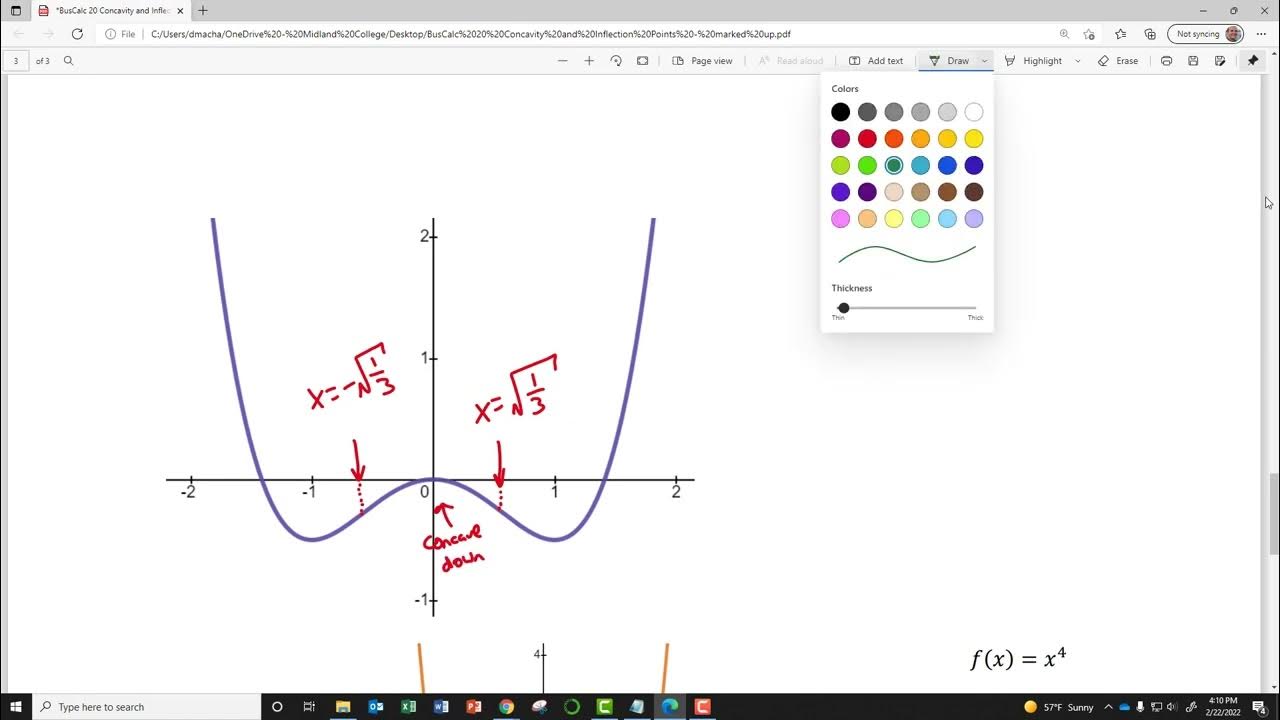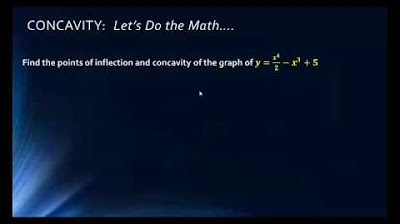Using the Second Derivative (2 of 2: Determining nature of stationary points)
TLDRIn this instructional transcript, the speaker guides through the process of identifying stationary points of a function without initially pinpointing their exact coordinates. They emphasize the importance of understanding the second derivative's role in determining the nature of these points, explaining that a positive second derivative indicates a concave up curve and thus a minimum point. The speaker also cautions against common mistakes, such as misinterpreting the second derivative's sign. Furthermore, they clarify that a zero second derivative does not guarantee a point of inflection, using a counterexample to illustrate the concept of concavity change, which is essential for identifying a true point of inflection. The lesson concludes with the recommendation to use a table of values for the second derivative to ascertain whether a point of inflection exists.
Takeaways
- 📚 The script discusses the process of finding and determining the nature of stationary points on a graph, emphasizing the importance of understanding the second derivative.
- 🔍 The speaker points out that stationary points require specific coordinates and that they can be found if desired, but the focus here is on the nature of these points.
- 📈 The second derivative is used to determine the concavity of a function, which in turn helps to identify whether a stationary point is a minimum or maximum.
- 📝 The speaker advises to test the second derivative at each stationary point to understand its sign and thus the nature of the point.
- 🤔 A common mistake is to jump to conclusions about the nature of a stationary point based solely on the value of the second derivative without considering its sign and what it implies about concavity.
- 📉 The second derivative's sign indicates whether the function is concave up (minimum) or concave down (maximum), with a positive second derivative suggesting a minimum point.
- 📌 The importance of understanding and communicating the reasoning behind the conclusions drawn from the second derivative is highlighted to avoid memorization without comprehension.
- 📊 The script uses an example to illustrate the process of finding a minimum point at x=3 and the corresponding y-value, reinforcing the method with a practical demonstration.
- 🔄 A counterexample is provided to show that a zero second derivative does not necessarily indicate a horizontal point of inflection, as concavity must change for an inflection point to exist.
- 📚 The function y = x^4 is used to demonstrate that even with a zero second derivative at a stationary point, there is no point of inflection if the concavity does not change.
- 📝 The necessity of testing the second derivative on both sides of a potential inflection point is emphasized to confirm a change in concavity, which is a requirement for an inflection point.
Q & A
What is the importance of finding stationary points in calculus?
-Stationary points are crucial in calculus as they indicate the points on a curve where the slope is zero, which can correspond to local maxima, minima, or points of inflection. Understanding these points helps in analyzing the behavior of functions.
Why does the speaker mention the need for coordinates to find stationary points?
-The speaker mentions the need for coordinates because stationary points are specific points on the graph of a function where the derivative is zero or undefined, and they are defined by their x and y values.
What is the significance of the second derivative in determining the nature of stationary points?
-The second derivative is significant because it provides information about the concavity of the function. A positive second derivative indicates that the function is concave up, suggesting a minimum, while a negative second derivative indicates concave down, suggesting a maximum.
Why does the speaker discourage jumping directly from the second derivative's sign to labeling a point as a maximum or minimum?
-The speaker discourages this because it skips the critical step of understanding what the second derivative signifies about concavity. This understanding is essential for correctly identifying the nature of the stationary point and for communicating the thought process behind it.
What is the common mistake students make when interpreting the second derivative's sign?
-A common mistake is to assume that a positive second derivative indicates a maximum, which is incorrect. A positive second derivative actually indicates a minimum because it means the function is concave up.
Why does the speaker emphasize the importance of understanding concavity when dealing with the second derivative?
-The speaker emphasizes this because understanding concavity is fundamental to correctly interpreting the second derivative. If a function is concave up, it has a minimum, and if it is concave down, it has a maximum.
What is the abbreviation the speaker uses for a minimum turning point, and why is it important to use it?
-The speaker uses 'concave up, a minimum turning point' as the abbreviation. It is important to use it because it clearly communicates the understanding of the second derivative's sign and its implication on the nature of the stationary point.
Why does the speaker introduce the concept of a horizontal point of inflection and then provide a counterexample?
-The speaker introduces the concept to illustrate that a stationary point found by setting the first derivative to zero does not automatically mean it is a point of inflection. The counterexample shows that the second derivative being zero does not guarantee a change in concavity.
What is the purpose of the counterexample involving the function y = x^4?
-The purpose of the counterexample is to demonstrate that a stationary point with a second derivative of zero does not necessarily indicate a point of inflection. It shows that the function is concave up everywhere, with no change in concavity, thus no point of inflection.
What additional step is required to determine if a stationary point is a point of inflection?
-To determine if a stationary point is a point of inflection, one must test the second derivative on either side of the point. A change in the sign of the second derivative indicates a change in concavity, which is the definition of a point of inflection.
Why does the speaker suggest creating a table of values for the second derivative?
-The speaker suggests creating a table of values for the second derivative to test for changes in concavity on either side of a stationary point. This is necessary to confirm whether the point is a point of inflection.
Outlines
📚 Understanding Stationary Points and Second Derivatives
The speaker introduces the concept of finding stationary points on a graph without specific coordinates. They discuss the traditional method of creating a table of values to estimate where stationary points might be, noting that these points can be far apart. The speaker then transitions to utilizing the second derivative to determine the nature of stationary points. They demonstrate this by evaluating the second derivative at x=0 and x=3, concluding that x=3 indicates a minimum due to the second derivative being positive, which suggests the graph is concave up at that point. The importance of understanding the mathematical logic behind the second derivative and concavity is emphasized to avoid common mistakes made by students.
📉 Locating Minimum Points and the Pitfalls of Inflection Misconceptions
The speaker proceeds to calculate the y-value of the minimum point found at x=3, resulting in the coordinates (3, -27) for the minimum point. They then address the potential misconception about horizontal points of inflection. To illustrate this, a counterexample is introduced with the function y = x^4, which also has a second derivative of zero at x=0. The speaker explains that despite the second derivative being zero, there is no point of inflection at the origin because the concavity does not change; it remains concave up. This serves as a cautionary tale against assuming a point of inflection solely based on the second derivative being zero.
🔍 Confirming Points of Inflection Through Second Derivative Sign Changes
The speaker concludes by emphasizing the need to verify a change in concavity to identify a point of inflection. They explain that one must test values on either side of a suspected point of inflection to see if the second derivative changes sign, indicating a change from concave up to concave down or vice versa. The speaker acknowledges that this process requires more work and suggests creating a table of values for the second derivative to accurately determine whether a point of inflection exists. They leave the detailed process for this verification to be completed by the viewer, focusing instead on the methodology for using the second derivative to determine the nature of stationary points.
Mindmap
Keywords
💡Stationary Points
💡Coordinates
💡Second Derivative
💡Concavity
💡Inflection Point
💡Derivative
💡Table of Values
💡Maximum and Minimum
💡Counterexample
💡Differentiation
Highlights
Introduction of a method to determine the nature of stationary points without finding their coordinates first.
Explanation of the process to find stationary points and the flexibility in the order of operations.
Advising to test closer to the stationary points rather than just halfway between them.
Introduction of using the second derivative to understand the nature of stationary points.
Demonstration of calculating the second derivative at specific points to determine concavity.
Clarification of the mathematical logic behind using the second derivative to determine concavity and its implications on the nature of stationary points.
Emphasizing the importance of understanding the second derivative's sign and its relation to concavity.
Highlighting the common mistake of misinterpreting the second derivative's sign and its implications on concavity.
Explanation of the correct interpretation of a positive second derivative indicating a minimum and concave up function.
Illustration of the process to find the y-value of a stationary point by substituting x back into the original function.
Identification of a stationary point at x=3 and calculation of its corresponding y-value to establish it as a minimum.
Introduction of a counterexample to illustrate why a zero second derivative does not guarantee a horizontal point of inflection.
Differentiation of a simpler function to find a stationary point and to demonstrate the concept of no change in concavity.
Discussion on the importance of understanding concavity changes to identify points of inflection accurately.
Explanation of the necessity to test the second derivative on both sides of a point to determine if it's a point of inflection.
Advice on using a table of values for the second derivative to ascertain changes in concavity for points of inflection.
Summary of the process to find stationary points and determine their nature using the second derivative.
Transcripts
Browse More Related Video

Point of Inflection - Point of Inflexion - f''(x)=0 - Definition - How to Find - Worked Example 1

BusCalc 20 Concavity and Inflection Points

MATH1325 Lecture 10 2 - Concavity & Points of Inflection

Using the Second Derivative (3 of 5: Why the Points of Inflexion may not exist when f"(x) = 0)

Differentiation (Maxima and Minima)

Learn how to determine concavity and point of inflection AP style
5.0 / 5 (0 votes)
Thanks for rating: